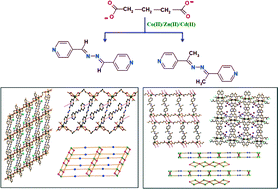Flexible dicarboxylate based pillar-layer metal organic frameworks: differences in structure and porosity by tuning the pyridyl based N,N′ linkers†
Abstract
Dicarboxylate supported metal organic hybrids of Co(II), Zn(II) and Cd(II) have been synthesized using two different pyridyl based N,N′ linkers having Schiff base functionalized site. The use of flexible dicarboxylate glutarate in designing such frameworks has created a marked diversity in topology. The different N,N′ donor linkers also played an active part in the channel modification in the synthesized MOFs. The structural and topological diversity has been analyzed from the single crystal X-ray structure. Five compounds, {[Co(azpy)(glut)]·(CH3OH)}n (1), {[Co(meazpy)(glut)(H2O)2]·(H2O)3}n (2), {[Zn(azpy)0.5(glut)(H2O)]·(azpy)0.5}n (3), {[Zn(meazpy)0.5(glut)(H2O)]·(H2O)2}n (4) and {[Cd(azpy)(glut)]·(CH3OH)}n (5), show porous structures with solvent accessible voids. The nature of the pores as well as the existence of lattice solvent molecules in 1 and 2 are different due to the use of a different pillar ligand in their fabrication. In case of 3 and 4 there are some nice effects of non-covalent interaction in the construction of their solid state structure, which has also originated by the change of pillar N,N′ donor linkers. Complex 5 is topologically as well as structurally similar to 1 forming a 2D-grid like structure. In {[Cd2(meazpy)2(glut)(NO3)]2}n (6) there is a formation of 2D sheets with the coordinated counter anion. Interestingly, here the sheets are disposed in a perpendicular fashion to each other and do not contain any solvent accessible void. Upon removal of the solvent molecules, the frameworks 1–5 show moderate CO2 and H2 uptake at 273 K and 77 K, respectively. The desolvated frameworks show different quantities of CO2 and H2 uptake which has been corroborated to their structures.

- This article is part of the themed collection: Introducing the CrystEngComm Advisory Board and their research

 Please wait while we load your content...
Please wait while we load your content...